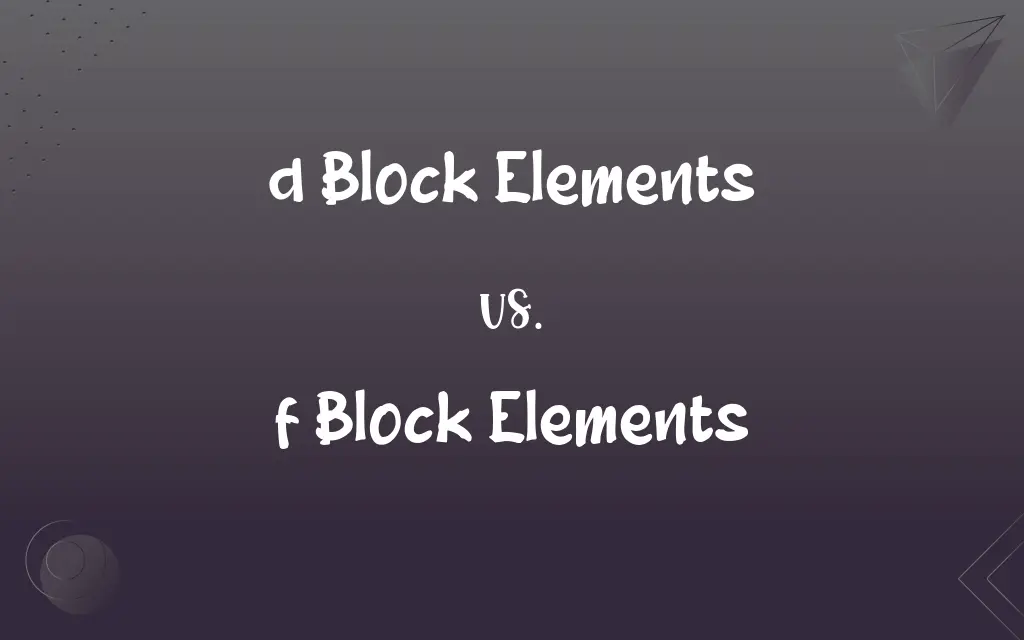d Block Elements vs. f Block Elements: What's the Difference?
Edited by Aimie Carlson || By Janet White || Published on March 24, 2024
D block elements fill the d orbital, forming the transition metals; f block elements fill the f orbital, including lanthanides and actinides.

Key Differences
D block elements are known as transition metals, characterized by their partially filled d orbitals. These elements are located in the center of the periodic table, from Groups 3 to 12. F block elements, on the other hand, include lanthanides and actinides, with their key feature being the filling of the f orbitals. These elements are typically shown below the main body of the periodic table to maintain its compact form.
The d block elements are renowned for their variable oxidation states, a result of the similar energy levels of their s and d orbitals. This allows them to form a variety of compounds with different properties. F block elements, particularly the actinides, also exhibit multiple oxidation states but are more complex due to the involvement of their f orbitals, which are more deeply buried and shielded within the atom.
Magnetic properties are prominent in d block elements due to their unpaired d electrons, making many of them paramagnetic. The f block elements, especially the lanthanides, exhibit strong magnetic properties due to their unpaired f electrons, which contribute significantly to their magnetic moments.
D block elements play crucial roles in industrial and biological processes, such as catalysts in chemical reactions and essential components in biological systems (e.g., iron in hemoglobin). F block elements are often associated with specialized applications, such as in superconductors, lasers, and nuclear reactors, due to their unique electronic and magnetic properties.
The chemical behavior of d block elements is relatively more predictable compared to f block elements, whose chemistry is dominated by the lanthanide contraction—the phenomenon where the atoms decrease in size across the lanthanide series, affecting their chemical behavior and making it more complex and less predictable.
ADVERTISEMENT
Comparison Chart
Orbital Filling
Partially fill the d orbital.
Partially fill the f orbital.
Location
Groups 3 to 12 in the periodic table's main body.
Below the main body, in the lanthanides and actinides rows.
Oxidation States
Exhibit variable oxidation states.
Complex multiple oxidation states, especially in actinides.
Magnetic Properties
Many are paramagnetic due to unpaired d electrons.
Strong magnetic properties due to unpaired f electrons.
Applications
Widely used in industrial processes and biology.
Specialized uses in superconductors, lasers, and nuclear reactors.
ADVERTISEMENT
d Block Elements and f Block Elements Definitions
d Block Elements
They are known for exhibiting multiple oxidation states.
Copper exhibits oxidation states of +1 and +2 in different compounds.
f Block Elements
F block elements are used in specialized applications.
Americium is used in smoke detectors.
d Block Elements
D block elements are often used as catalysts.
Platinum is used as a catalyst in fuel cells.
f Block Elements
Actinides in the f block are known for their radioactivity.
Uranium is used as fuel in nuclear reactors.
d Block Elements
D block elements are essential in various biological processes.
Zinc is crucial for enzyme function in biological systems.
f Block Elements
F block elements include lanthanides and actinides with partially filled f orbitals.
Neodymium, an f block element, is used in powerful magnets.
d Block Elements
D block elements are metals with partially filled d orbitals.
Iron, a d block element, is essential for manufacturing steel.
f Block Elements
They exhibit complex chemistry due to the lanthanide contraction.
Europium is used in fluorescent lamps for its distinctive red emission.
d Block Elements
Many d block elements are paramagnetic.
Cobalt is paramagnetic due to its unpaired d electrons.
f Block Elements
Lanthanides are known for their magnetic and optical properties.
Terbium is used in solid-state devices due to its magnetic properties.
FAQs
Can d block elements be magnetic?
Yes, many d block elements are magnetic due to their unpaired d electrons.
Why are d block elements called transition metals?
They are called transition metals due to their position in the periodic table and their ability to form compounds with varying oxidation states.
How do f block elements differ from d block elements?
F block elements have partially filled f orbitals, including lanthanides and actinides, with more complex electron configurations.
What are the lanthanide and actinide series?
The lanthanide series includes elements 57-71, and the actinide series includes elements 89-103, both part of the f block.
What is the lanthanide contraction?
The lanthanide contraction refers to the gradual decrease in the size of lanthanide atoms due to increasing nuclear charge.
How do oxidation states vary in d block elements?
D block elements exhibit a range of oxidation states because their s and d orbitals are close in energy.
What defines d block elements?
D block elements are characterized by their partially filled d orbitals, forming transition metals.
Are all f block elements radioactive?
Not all, but many actinides are radioactive due to their large atomic numbers and unstable nuclei.
What role do d block elements play in biology?
They are crucial for various biological processes, like iron in oxygen transport and zinc in enzyme function.
How do d block elements react chemically?
They form a variety of compounds, displaying different oxidation states and coordination numbers.
Why are some f block elements important in technology?
Their unique properties make them essential in electronics, magnets, and nuclear applications.
How do f block elements contribute to modern materials?
They are crucial in developing high-strength magnets, phosphors, and nuclear materials.
What is the environmental impact of extracting f block elements?
Mining and processing can be environmentally challenging, particularly for rare earth elements in the lanthanide series.
Why are f block elements used in specialized applications?
Their unique electronic, magnetic, and radioactive properties make them suitable for specific advanced applications.
What makes f block elements chemically complex?
Their electron configurations lead to complex chemical behaviors, influenced by the lanthanide contraction.
How does the electronic configuration of d block elements affect their properties?
The configuration leads to variable oxidation states, influencing their chemical and physical properties.
What challenges exist in studying f block elements?
Their complex electron configurations and radioactivity make them challenging to study and handle.
Are d block elements typically good conductors?
Yes, they are generally good conductors of electricity and heat due to their metallic nature.
Can f block elements be found in nature?
Yes, many lanthanides are relatively abundant, but most actinides are rare or synthetic.
What is the significance of unpaired electrons in d block elements?
Unpaired electrons contribute to their chemical reactivity, magnetic properties, and ability to form complexes.
About Author
Written by
Janet WhiteJanet White has been an esteemed writer and blogger for Difference Wiki. Holding a Master's degree in Science and Medical Journalism from the prestigious Boston University, she has consistently demonstrated her expertise and passion for her field. When she's not immersed in her work, Janet relishes her time exercising, delving into a good book, and cherishing moments with friends and family.
Edited by
Aimie CarlsonAimie Carlson, holding a master's degree in English literature, is a fervent English language enthusiast. She lends her writing talents to Difference Wiki, a prominent website that specializes in comparisons, offering readers insightful analyses that both captivate and inform.































































